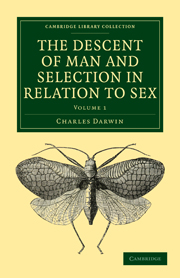CHAPTER VIII - PRINCIPLES OF SEXUAL SELECTION
Published online by Cambridge University Press: 29 August 2010
Summary
With animals which have their sexes separated, the males necessarily differ from the females in their organs of reproduction; and these afford the primary sexual characters. But the sexes often differ in what Hunter has called secondary sexual characters, which are not directly connected with the act of reproduction; for instance, in the male possessing certain organs of sense or locomotion, of which the female is quite destitute, or in having them more highly-developed, in order that he may readily find or reach her; or again, in the male having special organs of prehension so as to hold her securely. These latter organs of infinitely diversified kinds graduate into, and in some cases can hardly be distinguished from, those which are commonly ranked as primary, such as the complex appendages at the apex of the abdomen in male insects. Unless indeed we confine the term “primary” to the reproductive glands, it is scarcely possible to decide, as far as the organs of prehension are concerned, which ought to be called primary and which secondary.
The female often differs from the male in having organs for the nourishment or protection of her young, as the mammary glands of mammals, and the abdominal sacks of the marsupials. The male, also, in some few cases differs from the female in possessing analogous organs, as the receptacles for the ova possessed by the males of certain fishes, and those temporarily developed in certain male frogs.
- Type
- Chapter
- Information
- The Descent of Man and Selection in Relation to Sex , pp. 253 - 320Publisher: Cambridge University PressPrint publication year: 2009First published in: 1871

